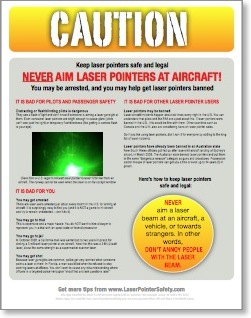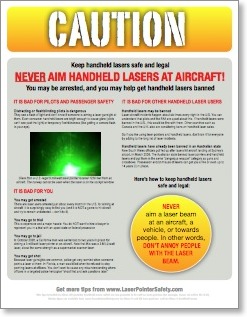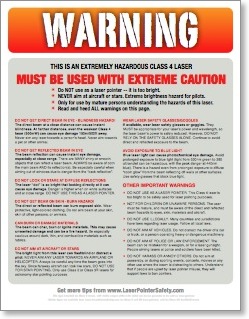Home
A comprehensive resource for safe and responsible laser use

How to reduce incidents: For laser pointer sellers, distributors and manufacturers
Laser pointers have already been banned in some jurisdictions. In Canada and elsewhere, aviation officials are getting fed up with pointers being aimed at aircraft. Therefore, it is in your best interest do to everything possible to promote the safe use of laser pointers and handheld lasers. Here are some suggestions:
Include safety flyer with order
Include with every order, a prominent “CAUTION” or “WARNING” flyer, giving users safety and responsible-use tips. We have created three flyers that sellers can use or modify, free of charge. Just click on the link to download a US-letter-sized PDF file.
Flyer for legal laser pointers (in the U.S., lasers less than 5 mW): insert-for-laser-pointers
Flyer for Class 3B handheld lasers, that are too powerful to be sold as laser “pointers”: insert-for-3Bhandheld-lasers
Flyer for Class 4 lasers (>500 mW) to inform users of the many potential hazards of these lasers: insert-for-Class4handheld-lasers
Other versions are available for you:
- Black-and-white versions are on the Files and Downloads page. It may be less expensive to print these, compared with the full-color versions below.
- If you need the original graphics file (in Mac iWorks “Pages” format), contact us using the information at the bottom of this page.
Education
Your website should have links to safety information at your website or at this website (LaserPointerSafety.com) on every page.
If you have a users forum, post information and a link to this site as a sticky on your forum.
On every webpage selling a laser pointer above 1 mW, there should be a prominent warning, such as “NEVER aim a laser beam at an aircraft. It is unsafe, you may be arrested, and you may help cause laser pointers to be banned.” (You may think 1 mW is too low; however a 1 mW laser is a distraction at aircraft altitudes. In 2008, a California man was jailed for aiming a 3.3 mW laser at an aircraft.)
Labeling
Every laser pointer above 1 mW should have a permanent marking or label with wording such as “DO NOT aim at or near aircraft”.
As of December 2012, U.S. regulators at the FDA now recommend (but cannot legally require) that laser pointers and handheld lasers have labels with the following (or similar) language: “CAUTION - LASER LIGHT IS BRIGHT AND BLINDING - DO NOT SHINE AT AIRCRAFT OR VEHICLES AT ANY DISTANCE.”
To give another example, in September 2009 a major Internet laser distributor began putting a warning on their U.S. labels: “WARNING: DO NOT SHINE YOUR LASER AT AN AIRCRAFT. Shooting a laser at an aircraft is considered a felony in the U.S.”
Label permanence
It should be difficult or impossible to remove the label. We understand this may be an aesthetic issue, but the label permanence is an important point. It should help reduce misuse. It is better to have some text on a pointer that can be legally used, than to have text-free pointers that have been banned due to too many laser-aircraft incidents.
Trade association
Laser pointer manufacturers, distributors and sellers should join together in a trade association. The association can provide “one voice” for the industry. The association can be a central resource for news about proposed laser pointer regulations. The association can work to educate users, in order to reduce incidents. The association can also work within groups such as the SAE G-10T Laser Safety Hazards Subcommittee, to help shape regulations.
To find out more about how to do this, please contact the author of this website, using the Contact us link at the bottom of this page.
Get involved in regulations and SAE G10T
Some countries are considering banning laser pointers. Pointer manufacturers, on their own or as part of a new trade association, can work with regulators in these countries to reduce incidents and to prevent or minimize a ban.
In the United States, a key laser-aviation safety group is the SAE G10T. Laser pointer interests should attend the SAE G10T meetings, so that their voice is heard. (They are held every six months, usually in February and August. For more information, contact ILDA.)